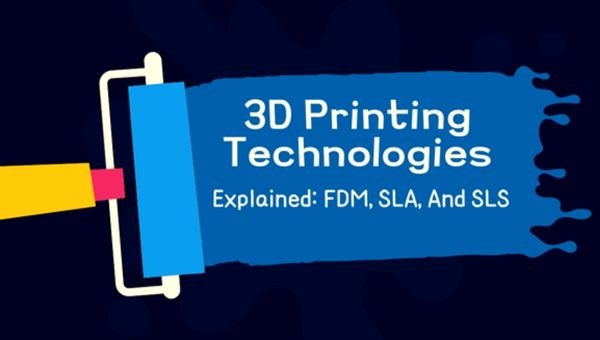3D printing is becoming an increasingly popular technology for producing parts, products and objects in a wide range of industries. But what is the difference between the three main 3D printing technologies – FDM, SLA and SLS?
In this article, we’ll break down each one and compare their pros and cons to help you decide which is best for your specific project or needs.
Introduction to 3D Printing Technologies
3D printer technology has come a long way in recent years, and there are now several different types of 3D printing technologies available on the market.
Each type of 3D printing technology has its own advantages and disadvantages, and it is important to choose the right type of 3D printer for your specific needs.
In this article, we will introduce you to three of the most popular types of 3D printing technologies:
- FDM
- SLA
- SLS
 FDM (Fused Deposition Modeling) is the most common type of 3D printing technology. FDM printers use a filament of plastic or other material that is melted and extruded through a nozzle to create a three-dimensional object.
FDM (Fused Deposition Modeling) is the most common type of 3D printing technology. FDM printers use a filament of plastic or other material that is melted and extruded through a nozzle to create a three-dimensional object.
FDM printers are typically less expensive than other types of 3D printers, and they are easy to use. However, FDM prints can be less accurate than prints from other types of 3D printers, and the objects that are printed with FDM technology can have visible layer lines.
SLA (Stereolithography) is another popular type of 3D printing technology. SLA printers use a laser to cure layers of photopolymer resin into solid objects. SLA prints can be very accurate, but they can be more expensive than FDM prints. Objects that are printed with SLA technology can also have visible layer lines.
SLS (Selective Laser Sintering) is the most widely used additive manufacturing technology for industrial applications, recognized by engineers and manufacturers across various industries for its ability to produce strong, functional parts.
1 What is FDM?
Fused Deposition Modeling (FDM) is a type of 3D printing technology that builds parts layer-by-layer from a filament of melted thermoplastic material.
An FDM printer extrudes the filament through a small, precise nozzle that moves back and forth across the build platform, depositing material in thin layers.
After each layer is deposited, the build platform lowers by one layer’s thickness and the process repeats until the part is complete.
- FDM technology is an additive manufacturing process, meaning it builds parts by adding material rather than subtracting it. This contrasts with traditional machining processes such as CNC milling or lathing, which remove material from a solid block to create a desired shape.
- One of the benefits of FDM over other 3D printing technologies is its versatility. FDM can print with a wide range of materials, including PLA, ABS, PC, PETG, nylon, and more. This makes it an ideal technology for prototyping and functional testing across a variety of applications.
- In addition to its wide range of compatible materials, FDM 3D printers also offer good mechanical properties for many applications. Parts printed with FDM technology can have high strength and stiffness, making them suitable for load-bearing or structural applications.
2 What is SLA?
SLA, or stereolithography, is an additive manufacturing technology that uses a laser to cure photopolymer resin into solid layers. SLA 3D printers are some of the most popular on the market due to their high accuracy and resolution.
3 What is SLS?
Selective Laser Sintering is a type of 3D printing that uses a laser to fuse together small particles of plastic, metal, or ceramic powder. The powder is spread out in a thin layer on a build platform, and the laser selectively fuses the powder together in the shape of the desired object.
SLS is one of the most popular 3D printing technologies for creating prototypes and low-volume production runs because it can create complex shapes that would be difficult or impossible to produce using other methods. Additionally, SLS 3D printers are typically very strong and have good dimensional accuracy.
The Difference Between FDM, SLA, and SLS
FDM, or fused deposition modeling, is the most common type of 3D printing. It works by extruding a thin layer of melted plastic onto a build platform. The plastic hardens as it cools, and the build platform lowers so that another layer can be deposited on top. This process is repeated until the model is complete.
SLA, or stereolithography, uses a laser to cure layers of photopolymer resin. The laser traces a cross-sectional profile of the model onto the surface of the resin. The exposed areas are solidified by the curing process and become part of the finished model.
SLS, or selective laser sintering, uses a laser to fuse together small particles of plastic, metal, or ceramic powder. The powder is spread evenly over a build platform and then selectively exposed to the laser beam according to the cross-sectional profile of the model. The resulting fusion produces a solid object with no need for support structures.
Advantages and Disadvantages of FDM, SLA, and SLS
1 Fused Deposition Modeling
Fused Deposition Modeling (FDM) is the most widely used 3D printing technology, and for good reason. It is a relatively simple process that can create complex parts quickly and easily.
However, there are some disadvantages to using FDM, such as the fact that parts made with this technology tend to be less accurate than those made with other methods.
2 Stereolithography
Stereolithography (SLA) is a 3D printing technology that uses a laser to cure layers of photopolymer resin into solid objects. SLA is capable of creating very accurate and detailed parts, but it is also a slower process than FDM. Additionally, SLA printers can be quite expensive.
3 Selective Laser Sintering
Selective Laser Sintering (SLS) is a 3D printing technology that uses a laser to fuse together small particles of plastic, metal, or ceramic powder.
SLS is capable of creating parts that are strong and durable, making it ideal for applications where traditional manufacturing methods would not be able to create the necessary parts.
However, SLS-printed parts can be quite expensive, and the process can produce hazardous fumes.
Conclusion
3D printing offers a great way to create products with little effort and maximum flexibility. With so many different types of printing technologies available, it can be difficult to decide which one is best for you.
We hope this article has helped explain the three most popular 3D printing technologies: FDM, SLA, and SLS. These technologies offer different advantages depending on your needs, so take some time to research each one in detail before making a final decision about which one will work best for you.







